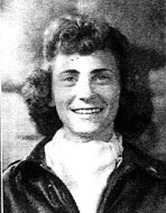|
The following is based on the text from the Army Air Force accident report No. 129, dated September 4, 1943. The report was provided by Craig Fuller of Aviation Archaeological Investigation & Research . |
|
Mabel was on a night training flight with her instructor 2nd Lt. Harvey J. Robillard. This was her first night flight at this base and it was about 9 PM. Prior to this flight, Mable had accumulated just over 200 hours of flight time in the WASP. This was in addition to her flying time prior to joining the WASP. A little over 10 of these hours were in an A-24 like the one they were flying this night at Camp Davis, North Carolina. According to the report, take-off and flight were normal until just before they started to land. In addition to the statement from the instructor, there were two other witness statements concerning the final moments of the flight. Frank J. Fitzgibbon, WO (Jg), was standing on the ramp in front of the hanger when the plane flew over during its attempted landing. He noted that based on "the sound and appearance of flames, the engine was operating on an extremely lean mixture. In my opinion, the airplane was not on fire, and crashed with the engine still operating." Staff Sergeant John A. Ross stated that while cleaning the day room, he "heard a plane overhead missing badly. The plane seemed to be unordinarily lit up by flames coming from the exhaust stacks." According to 2nd Lt. Robillard, who was seriously injured during the crash, "We were circling 2,000 feet at South Zone at about 2100. The tower called and told us to shoot a landing on Runway 4. She entered the pattern normal way at 1100 feet and cut gun to let wheels down. Soon it seemed something was wrong. I felt the throttle moving back and forth and realized the engine was dead. By that time we had 700 feet and were across runway and there turning to the left. I took over and told the student to jump. I then shouted at the student to jump. I had little time to look and see if she jumped. Somehow I knew she hadn't. I attempted to bring the plane in for a crash landing on the end of Runway 4. The next thing I felt the airplane shudder and I remember no more." The AAF report summarized these statements and possibly others with the following: "Halfway through the first 90 degree turn to the left the safety pilot took over and attempted to bring the plane in wheels down. He ordered the Woman Pilot to jump. He finished the first 90 degree turn, flew an abbreviated down wind and base leg, and was trying to round out a turn on to final approach when the plane crashed into the trees from a half stall inturn at low altitude. The plane broke into halves at the fuselage at the point of the rear cockpit. The safety pilot was thrown clear but the plane burned. The woman pilot did not jump and was burned to death strapped in the cockpit. The wrecked plane rests about 300 yards from the end of Runway 4. A wide drainage ditch and jungle like trees and swamp undergrowth handicapped rescue efforts." There is no mention in this report of a faulty latch in the front cockpit where Mabel was seated. This faulty latch is referred to in other WASP books and in a message from Mabel's sister. |
|
For more on Mabel, read her biography. |
Lois Hailey.
|
At the 1998 WASP reunion in Omaha, Nebraska, two film crews were present and interviewing many of the WASP. During the Saturday night banquet, one of the film crews asked for the table of the pilots who flew at Camp Davis. In particular, they were looking for Lois Hollingsworth Ziler. Lois identified herself. She was at a table with my mother , Betty Budde Dueser , Ema Colter Ware, all from Camp Davis, and myself. The film crew wanted to know about Mable's accident. They had understood that someone had put sugar in the planes fuel tank and wanted that substantiated for the film. All four WASP denied that rumor. One WASP made the point that like many things during the war, sugar was rationed and hard to come by. Using it to cause trouble was very unlikely. |





